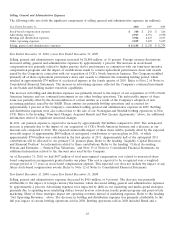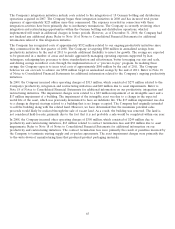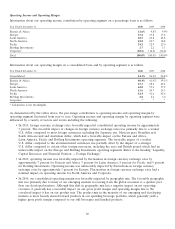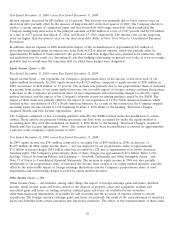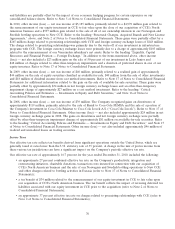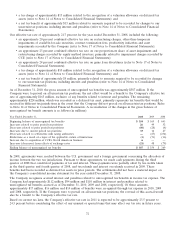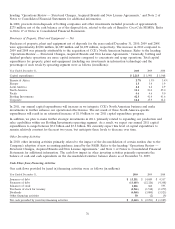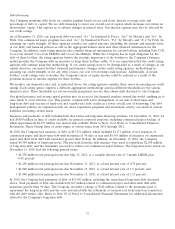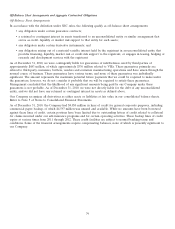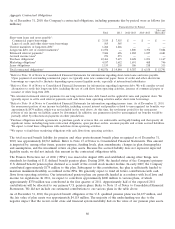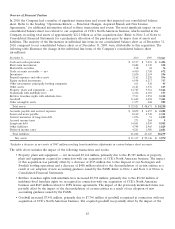Coca Cola 2010 Annual Report Download - page 75
Download and view the complete annual report
Please find page 75 of the 2010 Coca Cola annual report below. You can navigate through the pages in the report by either clicking on the pages listed below, or by using the keyword search tool below to find specific information within the annual report.Liquidity, Capital Resources and Financial Position
We believe our ability to generate cash from operating activities is one of our fundamental financial strengths. The
near-term outlook for our business remains strong, and we expect to generate substantial cash flows from operations in
2011. As a result of our expected strong cash flows from operations, we have significant flexibility to meet our financial
commitments. We typically fund a significant portion of our dividends, capital expenditures, contractual obligations,
share repurchases and acquisitions with cash generated from operating activities. We rely on external funding for
additional cash requirements. The Company does not typically raise capital through the issuance of stock. Instead, we
use debt financing to lower our overall cost of capital and increase our return on shareowners’ equity. Refer to the
heading ‘‘Cash Flows from Financing Activities,’’ below. Our debt financing includes the use of an extensive commercial
paper program as part of our overall cash management strategy. The Company reviews its optimal mix of short-term
and long-term debt regularly.
On October 2, 2010, we acquired CCE’s North American business. Under the terms of the merger agreement, the
Company acquired the 67 percent of CCE’s North American business that was not already owned by the Company for
consideration that included: (1) the Company’s 33 percent indirect ownership interest in CCE’s European operations;
(2) cash consideration; and (3) replacement awards issued to certain current and former employees of CCE’s North
American and corporate operations. At closing, CCE shareowners other than the Company exchanged their CCE
common stock for common stock in a new entity, which was renamed Coca-Cola Enterprises, Inc. (which is referred to
herein as ‘‘New CCE’’) and which continues to hold the European operations held by CCE prior to the acquisition. At
closing, New CCE became 100 percent owned by shareowners that held shares of common stock of CCE immediately
prior to the closing, other than the Company. As a result of this transaction, the Company does not own any interest in
New CCE.
Although the CCE transaction was structured to be primarily cashless, under the terms of the merger agreement, we
agreed to assume approximately $8.9 billion of CCE debt. In the event that the actual CCE debt on the acquisition date
was less than the agreed amount, we agreed to make a cash payment to New CCE for the difference. As of the
acquisition date, the debt assumed by the Company was approximately $7.9 billion. The total cash consideration paid to
New CCE as part of the transaction was approximately $1.3 billion, which included approximately $1.0 billion related to
the debt shortfall.
On November 15, 2010, the Company issued $4,500 million of long-term notes and used some of the proceeds to
repurchase $2,910 million of long-term debt. The remaining cash from the issuance was used to reduce our outstanding
commercial paper balance. The Company recorded a charge of $342 million related to the premiums paid to repurchase
the long-term debt and the costs associated with the settlement of treasury rate locks issued in connection with the debt
tender offer. Refer to Note 10 of Notes to Consolidated Financial Statements for additional information related to the
Company’s long-term debt.
In a concurrent transaction, we sold all of our ownership interests in our Norwegian and Swedish bottling operations to
New CCE for approximately $0.9 billion in cash on October 2, 2010. The Norwegian and Swedish bottling operations
were wholly-owned subsidiaries of the Company prior to the divestiture. This divestiture was pursuant to the terms of
the definitive agreement entered into on March 20, 2010. In addition, we granted New CCE the right to acquire our
majority interest in CCEAG, 18 to 39 months after the date of the merger agreement, at the then current fair value
and subject to terms and conditions as mutually agreed.
In contemplation of the closing of our acquisition of CCE’s North American business, we reached an agreement with
DPS to distribute certain DPS brands in territories where DPS brands had been distributed by CCE prior to the CCE
transaction. Under the terms of our agreement with DPS, concurrently with the closing of the CCE transaction, we
entered into license agreements with DPS to distribute Dr Pepper trademark brands in the U.S., Canada Dry in the
Northeast U.S., and Canada Dry and C’ Plus in Canada, and we made a net one-time cash payment of $715 million to
DPS. Under the license agreements, the Company agreed to meet certain performance obligations to distribute DPS
products in retail and foodservice accounts and vending machines. The license agreements have initial terms of
20 years, with automatic 20-year renewal periods unless otherwise terminated under the terms of the agreements. The
license agreements replaced agreements between DPS and CCE existing immediately prior to the completion of the
CCE transaction. In addition, we entered into an agreement with DPS to include Dr Pepper and Diet Dr Pepper in our
Coca-Cola Freestyle fountain dispensers in certain outlets throughout the United States. The Coca-Cola Freestyle
agreement has a term of 20 years.
73


